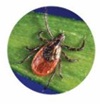Anaplasmosis

Anaplasmosis (formerly called human granulocytic ehrlichiosis) is caused by the bacterium Anaplasma phagocytophilum. It is spread to people through the bite of an infected Black-legged (“deer”) tick (Ixodes scapularis). Treatment is available; however if it is delayed, or there are underlying medical conditions, symptoms can become more severe. The best way to prevent anaplasmosis is to prevent tick bites.
Information for Clinicians
National Surveillance Case Definition
Connecticut Laboratory Reporting Information
Reportable Laboratory Findings form, OL-15C
Directory of Clinical Testing Services provided by the State Public Health Laboratory
State Public Health Laboratory Contacts – for additional information
Tick-borne Diseases of the United States – a Reference Manual for Healthcare Providers
Connecticut Anaplasmosis Surveillance
In 2008, the Centers for Disease Control and Prevention established a surveillance case definition for anaplasmosis and the Connecticut Department of Public Health (DPH) added the disease to the list of state-wide reportable diseases. Since 2008, an average of 69 cases (range 22 to 120) have been reported to the DPH annually.
Cases of Anaplasmosis reported to the DPH from January 1 - December 31, 2019
297 Confirmed
Connecticut Annual Infectious Diseases Statistics
This page last updated 1/14/2020.

